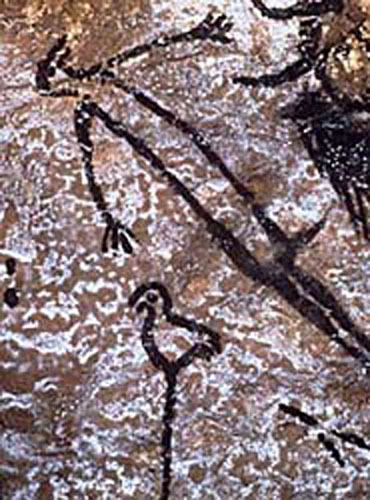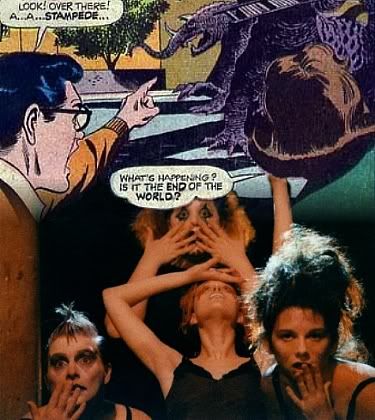Unconscious Kingdom (Part One)

The writing on the wall, come read it, come see what it say - Bob Dylan
This narration opens Lars von Trier's Riget ("The Kingdom"):
The Kingdom Hospital rests on ancient marshland where the bleaching ponds once lay. Here the bleachers moistened their great spans of cloth. The steam evaporating from the wet cloth shrouded the place in permanent fog. Centuries later the hospital was built here. The bleachers gave way to doctors and researchers, the best brains in the nation and the most perfect technology. To crown their work they called the hospital The Kingdom. Now life was to be charted, and ignorance and superstition never to shake the bastions of science again.
Perhaps that arrogance became too pronounced, and their persistent denial of the spiritual. For it is as if the cold and damp have returned. Tiny signs of fatigue are appearing in the solid, modern ediface. No living person knows it yet, but the gateway to the Kingdom is opening once again.
When the gateway opens, what comes through are phantom ambulances, the undead, child ghosts - etheric manifestions that affront the materialist reductionism of the Kingdom's staff, who believe their beliefs represent the highest expression of humanity's ascent from superstition. But their rationalism is finally ineffectual to support their pinched worldview against the chthonic onslaught - much like the real-life experience of the Livermore Laboratories scientists who found they "couldn't go home again" - and turned to despised ritual, trance and voodoo-like sacrifice in order to meet and bargain with the otherworldly elements that had erupted in their world.
But the message of The Kingdom's preamble is that the otherworld is what our world was before it was our world. That is, that we are inheritors of strange and ancient lands. Our ancestors, the first inheritors, knew; but for the better part we have forgotten. Though not all, and some perhaps not the best of us.
Our fully-human forefathers who lived before history left ubiquitous traces of their inner lives on cave walls and rock faces. Remarkably, across enormous distance and time the imagery remained conspicuously familiar, and religious. From all inhabited continents, and from the Upper Paleolithic to traditional cultures which until our own time contributed in isolation to the collective body of sacred art, we find the same recurring abstract geometric patterns, and similar depictions of shapeshifters in various stages of transformation. (It's interesting to note how now, after the "end" of history, the shapeshifter figure occupies again the shadows of our consciousness at the borderland of worlds. A recent example is the pseudo-documentary "Brandon Corey Story," a slick piece of disinfotainment that exploits our authentic apprehensions by fabricating evidence upon legitimate suspicions.)
Graham Hancock devotes much of his recent Supernatural to cave art, with particular attention paid to the finding of palaeoanthropologist David Lewis-Williams that its imagery appeared to be the language of universal trance states:
At some stages of the visionary experience subjects in laboratory tests report seeing displays of specific kinds of abstract geometrical patterns. What is interesting is the evidence that such patterns are universal and culture-free. Once we have entered a state of consciousness that has been altered deeply enough - itself a universal neurological capacity for the human race - it seems that everyone, everywhere experiences visions containing very much the same combinations of patterns and shapes.
Whether achieved by the ingestion of psychoactive drugs, spirit dancing or some other ritual, the trance-state of a shaman is essentially the same phenomenon regardless of time and place, as it is an unequivocally human event. Displays of geometric patterns are often followed by scenes of hybrid animals and impressions of great and alien intelligence, leading to the message the shaman sought to carry back to his people from the spirit world. If Lewis-Williams is right, then much cave art is an iconography of these altered states, and perhaps traditional cultures' own attempt at their interpretation.
I think this is important as well as interesting, because despite our modern and post-modern embarrassment, the spirit realm - and whatever we may mean by that - has spoken to humanity since before we had words to respond. That so many now live as though spirit didn't exist doesn't mean that spirit isn't still talking to us. If we don't again raise spirit to consciousness, then we have no discernment regarding this bug in our ear, loudly buzzing. (Also, I believe this to be important because caves may not only be our heritage but also our inheritance; if not literally, then quite possibly near enough.)
The German soldiers in Afghanistan who desecrated human remains by securing a skull on their vehicle's towing winch, and the one who held it next to his penis for a trophy photograph - is this learned behaviour? The ritualized pederasty found around the world, from ancient times to the present - how have disparate cultures come to the same religious sex practice? These are deeply buried things that are rarely brought to consciousness. Which is why I believe characters like Gilles de Rais and Elizabeth Bathory merit some attention, and why art has attributes which may inform us more about our predicament than plodding Reason.

By the way, here's a story that may deserve attention, while we keep this under consideration:
DNA switch developed to interface living organisms with computers
Researchers at the University of Portsmouth have developed an electronic switch based on DNA - a world-first bio-nanotechnology breakthrough that provides the foundation for the interface between living organisms and the computer world.
The new technology is called a 'nanoactuator' (shown in the image above) or a molecular dynamo. The device is invisible to the naked eye - about one thousandth of a strand of human hair.
The DNA switch has been developed by British Molecular Biotechnology expert Dr Keith Firman at the University of Portsmouth working in collaboration with other European researchers.
Dr Firman and his international team have been awarded a €2 million (£1.36m) European Commission grant under its New and Emerging Science and Technology (NEST) initiative to further develop this ground-breaking new technology.
But the DNA switch has immediate practical applications in toxin detection, and could be used in a biodefence role as a biological sensor to detect airborne pathogens.
The future applications are also considerable, including molecular scale mechanical devices for interfacing to computer-controlled artificial limbs.
'The possibilities are very exciting. The nanoactuator we have developed can be used as a communicator between the biological and silicon worlds,' Dr Firman said.
Our next cave walls may be silicon, and they may be inside us.














